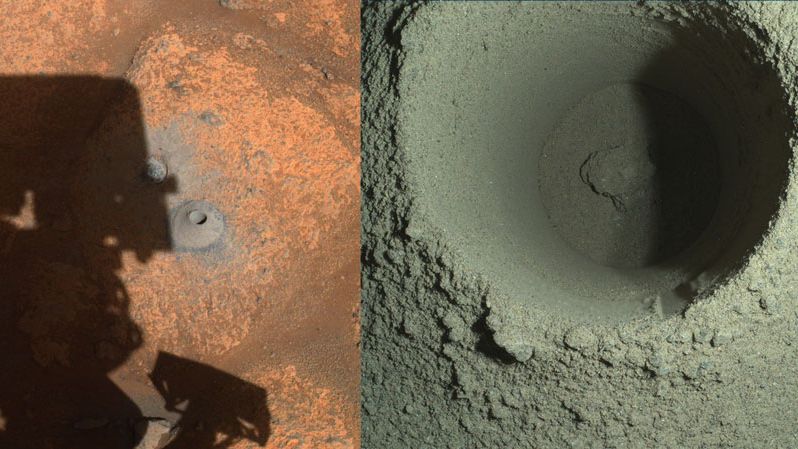There’s a military adage that no plan survives first contact with the enemy. While we haven’t gone to war with Mars, at least not yet, it does seem to be a place where the best-laid scientific plans are tested in the extreme. And the apparent failure of Perseverance to retrieve its first Martian core sample is yet another example of just how hard it is to perform geotechnical operations on another planet.
To be sure, a lot about the first sampling operation went right, an especially notable feat in that the entire process is autonomous. And as we’ve previously detailed, the process is not simple, involving three separate robotic elements that have to coordinate their operations perfectly. Telemetry indicates that the percussive drill on the end of the 2.1 m robotic arm was able to use its hollow coring bit to drill into the rock of Jezero crater, and that the sample tube inside the coring bit was successfully twisted to break off the core sample.
But what was supposed to happen next — jamming of the small core sample inside the sample tube — appears not to have happened. This was assessed by handing the sample tube off to the Sample Handling Arm in the belly of Perseverance, where a small probe is used to see how much material was recovered — none, in this case. NASA/JPL engineers then began a search for the problem. Engineering cameras didn’t reveal the core sample on the Martian surface, meaning the sample handling robots didn’t drop it. The core sample wasn’t in the borehole either, which would have meant the camming mechanism designed to retain the core didn’t work. The borehole, though, looked suspicious — it appears not to be deep enough, as if the core sample crumbled to dust and packed into the bottom of the hole.
If this proves to be the cause of the failure, it will be yet another example of Martian regolith not behaving as expected. For InSight, this discovery was a death knell to a large part of its science program. Thankfully, Perseverance can pick up and move to better rock, which is exactly what it will be doing in September. They still have 42 unused sample tubes to go, so here’s to better luck next time.
[Featured images: NASA/JPL-Caltech]
















I can see a volcanic cone shape suggesting the core became some kind of flour and piled up round the sides.
That’s from cutting. Use a hole saw in wood and you’ll get the same thing
Why is the dirt gray?
The rock that was drilled might not contain as much iron as the red dust, or if it does, it wasn’t iron(III)-oxide but some other compound.
It’s Mars, dude
The studio messed it up. One can clearly see it´s powdered clay.
“…how hard it is to perform geotechnical operations on another planet.”
Why, yes, I imagine it would be. :-)
I suppose it would be areotechnical in this case.
Not quite. Mars geology is a thing: https://en.wikipedia.org/wiki/Geology_of_Mars
geo = “earth”
Even in 1972, when geologist Harrison Schmitt walked on the moon, they called it selenology.
By extension, the prefix geo- would not apply to Mars, where areo- might be more appropriate.
But English is pretty malleable, the the folks who have the free time to edit wikipedia pages are the victors, because they write the history…
My university calls the lectures about Mars “planetary geology” but I prefer exogeology because it is brief.
I think if I were to start a colony in another star system, I would name the star “Dover”.
Then the colonists would be going to Star Dover (start over).
Nevermind the semantics, I wanna rock!
Overspecializing the tools seems to have blown up in their faces. It does make me wonder if they will send a machine with “hands” at some point.
You should apply for a job there.
I am wondering if the martian insects are interfering with the drilling?
I spotted one here earlier in the raw images from Sol 170:
https://pbs.twimg.com/media/E8r3pjnXEAE9IYb?format=jpg&name=large
that’s just a bug
How about for the next collection mission we just send a long distance rover and a bit “anvil”, on re-enrty the rover lands and the “anvil” makes a crater which the rover drives to and scoops up the dust, no fuss, no muss.
Even quicker: send it with dynamite.
> While we haven’t gone to war with Mars
… really? Why did a green mist accompanied by a large cylinder suddenly appear in my back yard last night? And no I don’t live in Horsell Common. :-P
https://en.wikipedia.org/wiki/The_War_of_the_Worlds